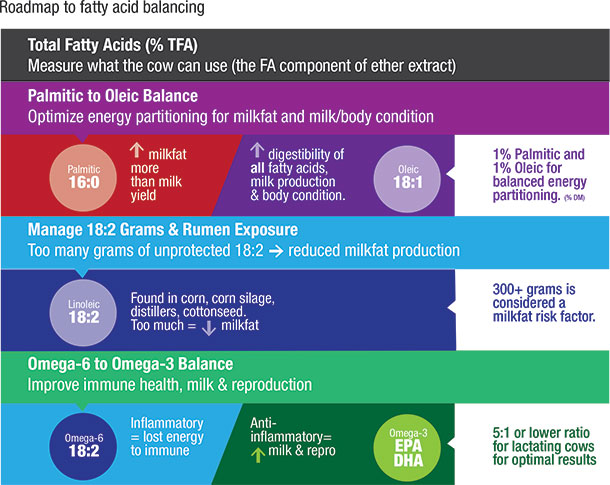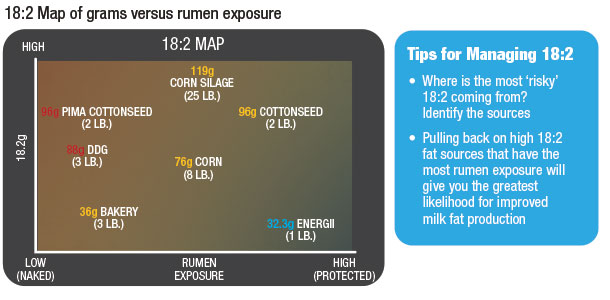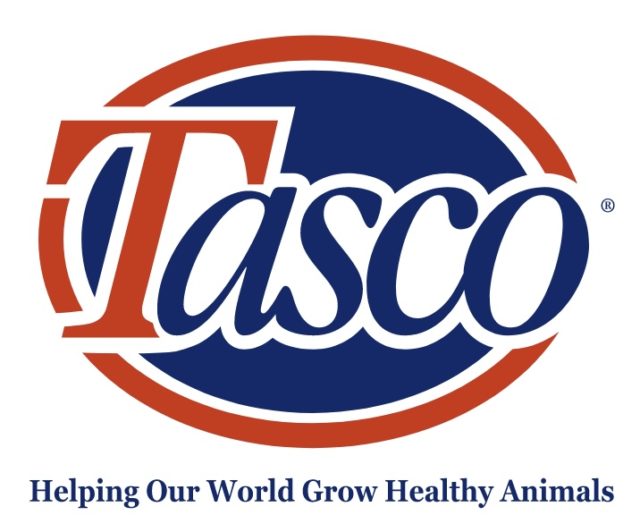And then let’s talk about their impact on milkfat depression – was it the high levels of 18:2 that caused milkfat to drop or was it the starch? Or a combination of the two, plus the overcrowding situation?
There’s a reason why many take a “set it and forget it” approach to fatty acids. They make sure fat levels are not too high in the diet and then pay careful attention to the other interacting factors, such as starch levels, starch degradability and fiber levels, to ensure a strong milkfat result. This basic approach has worked well for many years.
Fatty acids have different roles
Today, however, we know very clearly that fat is not simply energy; rather fat is made of individual fatty acids that all play different roles (image above) beyond milkfat. Palmitic directly affects milkfat production at the mammary gland, while the higher-digestible oleic improves feed efficiency and reduces body condition loss.
Meanwhile, 18:2 (omega-6) has pro-inflammatory effects which can improve transition performance when fed to close-ups; yet too much 18:2 in the lactating diet is a major milkfat risk factor and a drain on energy due to inflammation. Lastly, the EPA/DHA omega-3s are highly anti-inflammatory and play vital roles in embryo development and maintenance of pregnancy.
Roadmap to fatty acid balancing

Given the global impact fatty acids have on both the cow’s physiology and performance, we’ve taken our best shot at outlining a “roadmap to fatty acid balancing” to both define and simplify the steps you can take toward better balancing fatty acids. Before you take your first step, let’s make sure we’re measuring total fatty acids (percent TFA) rather than ether extract, since TFA is what the cow can utilize.
1. Palmitic-to-oleic balance: Palmitic fatty acid is known to deliver more energy to the mammary gland to increase milkfat. Whereas oleic improves total digestibility of fatty acids at the small intestine, thus improving feed efficiency and reducing body condition loss in early lactation. Since the invention of calcium salts of palm oil (50% palmitic, 35% oleic) by Jenkins and Palmquist in the late ’80s, palmitic fatty acid has been a standard addition to our dairy diets. In recent years, palmitic prills (86% palmitic, 9% oleic) entered the market, providing a way to deliver higher concentrations of palmitic to the cow and thus deliver more fatty acids for milkfat synthesis. However, balance is key, since whenever palmitic concentration goes up in the fat supplement, oleic levels go down.
The debate (and experimentation on dairies) has been an active one, to say the least. How much palmitic versus oleic should be fed to cows? And how should that differ across stage of lactation to meet the needs of the mammary gland versus the cow? Recent research from Michigan State suggests that feeding a more balanced approach (60:30 palmitic versus oleic) in early lactation allows for significant gains in energy-corrected milk (ECM) and increases in dry matter intake (DMI). It also reduced bodyweight loss versus the higher palmitic treatment (80:10), which resulted in similar gains in ECM but with no difference in DMI and greater losses in early lactation bodyweight.
We need to be assessing the palmitic-oleic balance in the whole diet, not simply what is in the fat supplement. Here’s a base guideline to start from:
Palmitic-oleic guideline: 1% palmitic and 1% oleic for balanced energy partitioning (percent DM, intake g)

2. Manage 18:2 grams and rumen exposure: Here’s where fatty acids and proactively managing milkfat come together. 18:2 is the main fatty acid we feed in large quantities and directly affects milkfat synthesis. It is impossible to get away from feeding 18:2 since it is high in corn, corn silage, distillers grain, cottonseed and soybeans.
The key to managing 18:2 is understanding the risk is twofold. How many grams are we sending to the rumen? How rumen-exposed are those grams? The 18:2 map on page 53 shows where the 18:2 is coming from versus rumen exposure, with the ingredients such as bakery and distillers having the greatest risk. While the number of grams is easy to account for with fatty acid analysis of silages and the TMR, rumen exposure of 18:2 has been harder to quantify.
No doubt, 18:2 is not the only thing affecting milkfat risk. It is simply one very important factor alongside other dietary factors (starch, starch degradability, fiber, yeast and mold levels), and management factors (bunk management, TMR mixing, stocking density and feeding frequency) that affect milkfat. What differentiates 18:2 versus other risk factors is it sits at the root of the mechanism for lowered milkfat. Too many grams of highly exposed 18:2 will quickly shift the rumen microbe population to an alternate (bad) pathway that directly reduces milkfat synthesis at the mammary gland.
18:2 guideline: 300-plus grams is considered a milkfat risk factor (Intake g)
3. Omega-6 to omega-3 balance: The third piece of fatty acid balance is focused on omega-6 and omega-3 fatty acids, as these are bioactive fatty acids highly involved in cell signaling within the immune system and reproductive processes. Omega-6s are inflammatory, while omega-3s are anti-inflammatory, so the balance of the two directly affects immune function and energy utilization due to inflammation. Let’s remember that omega-6 is also 18:2. The same fatty acid that can wreak havoc on milkfat can also cause cellular inflammation, costing the cow energy that could have been used for production.
Most dairy diets are heavily weighted to the omega-6 inflammatory side and quite low in anti-inflammatory EPA/DHA omega-3s. Opportunities exist with several CA salts of EPA/DHA products on the market to effectively deliver the few grams needed to the small intestine to significantly shift inflammatory status, improve embryo retention and milk production efficiency. While the focus has primarily been on adding omega-3s to improve the balance, it is worth exploring ways to pull back a little on omega-6 (18:2) as well to not only reduce inflammation but also reduce milkfat risk.
Omega-6 to omega-3 guideline: 5:1 omega-6 to omega-3 ratio or lower (absorbed g)
Building your fatty acid habit
If you balance dairy diets for a living, you know this is simply about creating a new habit. Be sure to have the key fatty acid parameters visible on the front page of your ration software, so it is not a chore to monitor how these fatty acid levels change as you make other ingredient changes. With the shortages in the distillers grain market, this is a perfect time to look back and see how 18:2 grams were affected as you made those substitutions for example. Also, consider adding fatty acid analysis to your regular silage testing to account for the variability in 18:2 grams.
If you’re a dairy producer, the best thing to remember from this discussion is: Fatty acids are not just about milkfat. Of course, milkfat is important, but we need to get beyond simply palmitic and ensure enough of the right fatty acids are provided for both the mammary gland and the cow. ![]()

-
Renee Smith
- Western Sales Manager
- Virtus Nutrition
- Email Renee Smith








